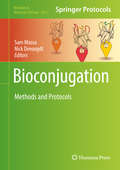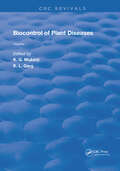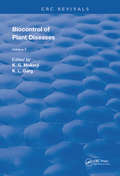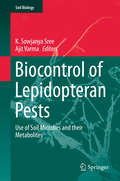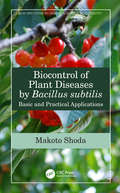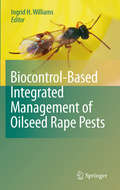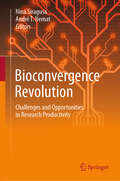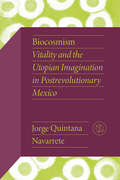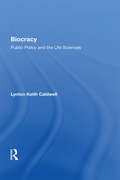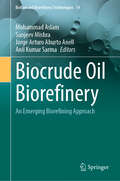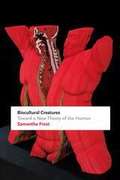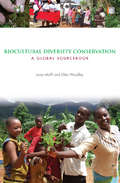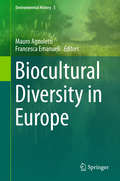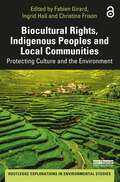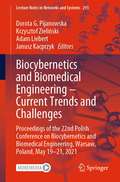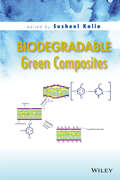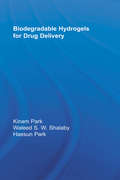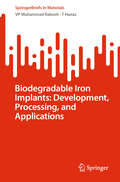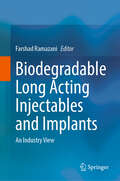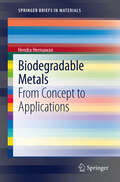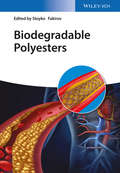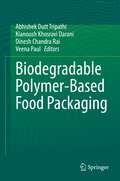- Table View
- List View
Bioconjugation: Methods and Protocols (Methods in Molecular Biology #2033)
by Sam Massa Nick DevoogdtThis book explores well-established and emerging conjugation strategies that are relevant for proteins used in the field of precision medicine, focusing on techniques that are suitable for antibodies, antibody-fragments such as Fabs, scFvs, or nanobodies, scaffold proteins such as FN3 or DARPin, peptides, or model proteins. Although centered on the development of bioconjugates rather than their application, most protocols also show the conjugation of the targeting vehicle to a diagnostic or therapeutic entity, with the end-product most often being an antibody-drug conjugate, an optical probe, a nanomedicine, or a radiopharmaceutical. Written for the highly successful Methods in Molecular Biology series, chapters include introductions to their respective topics, lists of the necessary materials and reagents, step-by-step, readily reproducible laboratory protocols, and tips on troubleshooting and avoiding known pitfalls. Authoritative and practical, Bioconjugation: Methods and Protocols is an ideal guide for researchers looking toward precision medicine in order to expand the vital field of drug discovery.
Biocontrol Of Arthropods Affecting Livestock And Poultry
by Donald A RutzThe adverse affects of pesticides and other toxic deterrents on the environment and human health are causing researchers to investigate biological methods for controlling arthropods - flies and mites - which negatively affect livestock and poultry. In this volume, scientists from ten countries examine the use of predators, competitors and pathogens as biological control agents for these pests. The range of topics discussed includes biocontrol as a component of integrated pest management systems in feedlots, pastures and confined animal housing, as well as the interactions of pesticides and biocontrol agents, population modelling and the potential for biocontrol in livestock and poultry pest management. The book is intended for scholars, policymakers and professionals working in veterinary and medical entomology, biological control and integrated pest management.
Biocontrol Of Plant Diseases (Routledge Revivals #1)
by K. G. Mukerji K.L. GargFirst Published in 1988, this set offers a comprehensive insight into controlling diseases in plants. Carefully compiled and filled with a vast repertoire of notes, diagrams, and references this book serves as a useful reference for biologists, horticulturalists, other practitioners in their respective fields.
Biocontrol Of Plant Diseases (Routledge Revivals #2)
by K. G. Mukerji K.L. GargFirst Published in 1988, this set offers a comprehensive insight into controlling diseases in plants. Carefully compiled and filled with a vast repertoire of notes, diagrams, and references this book serves as a useful reference for biologists, horticulturalists, other practitioners in their respective fields.
Biocontrol of Lepidopteran Pests: Use of Soil Microbes and their Metabolites (Soil Biology #43)
by Ajit Varma K. Sowjanya SreeThis volume describes the various applications of entomopathogenic soil microorganisms in the management and control of the devastating lepidopteran pest. An introduction describes the insecticidal properties of viruses, bacteria, fungi, nematodes and their metabolites, as well as their applications in the context of crop improvement. Subsequent chapters focus on topics such as insecticidal proteins; the role of nucleopolyhedroviruses; Bt toxins and their receptors; control of lepidopterans using entomopathogenic fungi; management of cotton defoliators; and sustainable use of entomopathogenic nematodes and their bacterial symbionts. An overview of culture collections of entomopathogenic microorganisms rounds out the volume.
Biocontrol of Plant Diseases by Bacillus subtilis: Basic and Practical Applications (New Directions in Organic & Biological Chemistry)
by Makoto ShodaPlant diseases are a serious threat to food production. This unique volume provides the fundamental knowledge and practical use of B.subtilis as a promising biocontrol agent. In order to replace chemical pesticides, one possibility is microbial pesticides using safe microbes. Bacillus subtilis is one of several candidates. Screening of the bacterium, the application of plant tests, clarification of its suppressive mechanism to plant pathogens and engineering aspects of suppressive peptides production are presented here. The author illustrates how B. subtilis is far more advantageous than, for example, Pseudomonas in biocontrol and can be considered as an useful candidate. Features: Bacterium B. subtilis suppresses many plant pathogens and is a biocontrol agent to replace chemical pesticides The book presents the bacterium's suppressive mechanism to plant pathogens, and engineering aspects of suppressive peptides production Biological control of plant disease plays an important role in sustainable agricultural production practices and is expected to replace agricultural chemicals
Biocontrol-Based Integrated Management of Oilseed Rape Pests
by Ingrid H. WilliamsOilseed rape is a major arable crop in both Europe and North America. It is attacked by unique complexes of insect pests still largely controlled through the application of chemical insecticides. Crop management systems for the future must combine sustainability with environmental acceptability to satisfy both social and economic demands. This book, in its 17 chapters each led by a world expert, reviews research progress towards developing integrated pest management systems for the crop that enhance conservation biocontrol. This approach is particularly timely because of the development in Europe of insecticide resistance in the pollen beetle, a major pest of the crop. The past decade has seen considerable progress in our knowledge of the parasitoids and predators that contribute to biocontrol, of their distribution patterns, and their behavioural ecology, both within and without the crop. There is potential for natural enemy conservation through modification of within-field crop husbandry practices, as well as, on the landscape scale, through habitat manipulation to encourage vegetational diversity. This book will prove invaluable as a text for researchers, university teachers, graduate scientists, extension workers and growers involved in integrated pest management.
Bioconvergence Revolution: Challenges and Opportunities in Research Productivity
by Nina Siragusa André T. NematThis book offers a comprehensive overview of how to utilize the bioconvergence revolution to substantially enhance research productivity. It carefully addresses critical issues such as ethical dilemmas, collaborative dynamics, funding, and operational efficiency, complete with concrete examples of how to overcome these challenges. Historically, the natural world has served as a profound source of inspiration for technological innovation. The natural materials, structures, and processes found in organisms have facilitated numerous scientific advancements. Presently, the integration of nature with scientific research is intensified through convergence. The book explores this convergence as a multidisciplinary approach that leverages the synergies among digital technologies, material sciences, and biotechnology, aiming to significantly accelerate and broaden the scope of scientific breakthroughs. This volume provides a scholarly account of the emerging opportunities catalyzed by bioconvergence, emphasizing the necessity for rigorous ethical frameworks and standards as biotechnologies and digital tools converge to explore new frontiers. It delves into the challenges of financing scientific advancement and articulates how funding underpins multidisciplinary research efforts. Featuring Israel as a leader in this revolutionary field, the book meticulously outlines the Israeli ecosystem as a paradigm of innovation in bioconvergence. This work possesses a broad interdisciplinary appeal, making it an essential resource for researchers in both industry and academia, as well as for scholars and funding bodies dedicated to the advancement of science.
Biocosmism: Vitality and the Utopian Imagination in Postrevolutionary Mexico (Critical Mexican Studies)
by Jorge Quintana NavarreteMost scholars study postrevolutionary Mexico as a period in which cultural production significantly shaped national identity through murals, novels, essays, and other artifacts that registered the changing political and social realities in the wake of the Revolution. In Biocosmism, Jorge Quintana Navarrete shifts the focus to examine how a group of scientists, artists, and philosophers conceived the manifold relations of the human species with cosmological forces and nonhuman entities (animals, plants, inorganic matter, and celestial bodies, among others). Drawing from recent theoretical trends in new materialisms, biopolitics, and posthumanism, this book traces for the first time the intellectual constellation of biocosmism or biocosmic thought: the study of universal life understood as the vital vibrancy that animates everything in the cosmos from inorganic matter to living organisms to outer space. It combines both analysis of unexplored areas—such as Alfonso L. Herrera&’s plasmogeny—and innovative readings of canonical texts like Vasconcelos&’s La raza cósmica to examine how biocosmism produced a wide array of utopian projects and theorizations that continue to challenge anthropocentric, biopolitical frameworks.
Biocracy: Public Policy And The Life Sciences
by Lynton Keith CaldwellBiocracy, a term invented by physiologist Walter Bradford Cannon, refers to the influence of biological science on society and its public policies. Beginning with the prophetic essay “Biopolitics: Science, Ethics, and Public Policy,†this book addresses various aspects of the relationships among the life sciences, society, and government. Included in the topics considered are some of the more critical issues of our time: the social responses to life science innovations; health and homeostasis as social concepts; the relationship between history and biology and that between the life sciences and the law; biocratic interpretations of ethical behavior and biopolitical conflicts; and the options, risks, and international consequences of biotechnology. Caldwell’s book is a collection of articles that he wrote on this subject over a period of twenty-five years. Of the ten chapters, four have previously appeared in scholarly journals but have undergone extensive editorial revisions appropriate to this publication. The remaining six chapters have been presented at various professional meetings but have not hitherto been available in print.
Biocrude Oil Biorefinery: An Emerging Biorefining Approach (Biofuel and Biorefinery Technologies #14)
by Mohammad Aslam Anil Kumar Sarma Sanjeev Mishra Jorge Arturo Aburto AnellBiorefineries are increasingly important in providing sustainable routes to the oil industry. This book provides a comprehensive analysis of biocrude biorefinery to convert biocrude into environmentally friendly fuels and high-value-added products.It begins by discussing the biorefinery concept with its fundamentals and biocrude biorefinery as a sustainable solution for bioenergy and the green economy, explaining the chemistry and reaction mechanism behind biocrude production and analysing the different feedstocks, including lignocellulosic biomass, for biocrude production, recent developments and associated challenges.The second part focuses on waste oils and liquid wastes for sustainable biocrude oil production in a biorefinery approach, as well as on 3rd generation of biorefinery feedstocks (algal biomass) as emerging feedstock for biocrude oil production and high-value products in biorefineries and biocrude oil derived from municipal and industrial organic wastes in the framework of a waste biorefinery concept. Furthermore, bio-oil constitutes a promising energy source for future hydrogen production as well as for the catalytic conversion of crude bio-oil into environmentally friendly transport fuels. The physicochemical and analytical techniques used for the analysis of crude bio-oil with fuel properties and international standards, as well as microbial production and its future applications are also covered.This book will be of great interest to practitioners, graduate students, researchers and policymakers involved in crude bio-oil biorefineries for sustainable development. This book also explores the relationship between biofuels and Sustainable Development Goals (SDGs) 7. Furthermore, the book lays a solid foundation for the establishment of crude bio-oil-based biorefineries and thus contributes to a sustainable, cleaner, greener and livable blue planet for the next generations. Crude bio-oil is likely to be the "green gold" of the biorefinery of the future and this book will be a milestone for biorefineries.
Biocultural Creatures: Toward a New Theory of the Human
by Samantha FrostIn Biocultural Creatures, Samantha Frost brings feminist and political theory together with findings in the life sciences to recuperate the category of the human for politics. Challenging the idea of human exceptionalism as well as other theories of subjectivity that rest on a distinction between biology and culture, Frost proposes that humans are biocultural creatures who quite literally are cultured within the material, social, and symbolic worlds they inhabit. Through discussions about carbon, the functions of cell membranes, the activity of genes and proteins, the work of oxygen, and the passage of time, Frost recasts questions about the nature of matter, identity, and embodiment. In doing so, she elucidates the imbrication of the biological and cultural within the corporeal self. In remapping the relation of humans to their habitats and arriving at the idea that humans are biocultural creatures, Frost provides new theoretical resources for responding to political and environmental crises and for thinking about how to transform the ways we live.
Biocultural Diversity Conservation: A Global Sourcebook
by Luisa Maffi Ellen WoodleyThe field of biocultural diversity is emerging as a dynamic, integrative approach to understanding the links between nature and culture and the interrelationships between humans and the environment at scales from the global to the local. Its multifaceted contributions have ranged from theoretical elaborations, to mappings of the overlapping distributions of biological and cultural diversity, to the development of indicators as tools to measure, assess, and monitor the state and trends of biocultural diversity, to on-the-ground implementation in field projects. This book is a unique compendium and analysis of projects from all around the world that take an integrated biocultural approach to sustaining cultures and biodiversity. The 45 projects reviewed exemplify a new focus in conservation: this is based on the emerging realization that protecting and restoring biodiversity and maintaining and revitalizing cultural diversity and cultural vitality are intimately, indeed inextricably, interrelated. Published with Terralingua and IUCN
Biocultural Diversity in Europe (Environmental History #5)
by Mauro Agnoletti Francesca EmanueliThe book collects a selection of the papers presented at the meeting held in the context of the Joint Programme on the Links between Biological and Cultural Diversity (JP-BiCuD). Recognizing the inextricable link between biological and cultural diversity, the United Nations Educational Scientific and Cultural Organization (UNESCO) and the Secretariat of the Convention on Biological Diversity (SCBD) joined forces, and in 2010 launched the Joint Programme on the Links between Biological and Cultural Diversity (JP-BiCuD). The first meeting for the implementation of the JP-BiCuD was held in Florence (Italy) in April 2014 and produced the UNESCO-sCBD Florence Declaration, which highlights the concept of biocultural diversity. The European rural territory is predominantly a biocultural, multi-functional landscape, providing a crucial and effective space for integration of biological and cultural diversity, suggesting the need to revise some of the current strategies for the assessment and management of biodiversity.
Biocultural Rights, Indigenous Peoples and Local Communities: Protecting Culture and the Environment (Routledge Explorations in Environmental Studies)
by Fabien GirardThis volume presents a comprehensive overview of biocultural rights, examining how we can promote the role of indigenous peoples and local communities as environmental stewards and how we can ensure that their ways of life are protected. With Biocultural Community Protocols (BCPs) or Community Protocols (CPs) being increasingly seen as a powerful way of tackling this immense challenge, this book investigates these new instruments and considers the lessons that can be learnt about the situation of indigenous peoples and local communities. It opens with theoretical insights which provide the reader with foundational concepts such as biocultural diversity, biocultural rights and community rule-making. In Part Two, the book moves on to community protocols within the Access Benefit Sharing (ABS) context, while taking a glimpse into the nature and role of community protocols beyond issues of access to genetic resources and traditional knowledge. A thorough review of specific cases drawn from field-based research around the world is presented in this part. Comprehensive chapters also explore the negotiation process and raise stimulating questions about the role of international brokers and organizations and the way they can use BCPs/CPs as disciplinary tools for national and regional planning or to serve powerful institutional interests. Finally, the third part of the book considers whether BCPs/CPs, notably through their emphasis on "stewardship of nature" and "tradition", can be seen as problematic arrangements that constrain indigenous peoples within the Western imagination, without any hope of them reconstructing their identities according to their own visions, or whether they can be seen as political tools and representational strategies used by indigenous peoples in their struggle for greater rights to their land, territories and resources, and for more political space. This volume will be of great interest to students and scholars of environmental law, indigenous peoples, biodiversity conservation and environmental anthropology. It will also be of great use to professionals and policymakers involved in environmental management and the protection of indigenous rights. The Open Access version of this book, available at www.taylorfrancis.com, has been made available under a Creative Commons Attribution-Non Commercial-No Derivatives 4.0 license
Biocybernetics and Biomedical Engineering – Current Trends and Challenges: Proceedings of the 22nd Polish Conference on Biocybernetics and Biomedical Engineering, Warsaw, Poland, May 19-21, 2021 (Lecture Notes in Networks and Systems #293)
by Janusz Kacprzyk Krzysztof Zieliński Dorota G. Pijanowska Adam LiebertThis book contains 13 chapters in which you can find various examples of the development of methods and/or systems supporting medical diagnostics and therapy, related to biomedical imaging, signal and image processing, biomechanics, biomaterials and artificial organs, modeling of biomedical systems, which, as the current research issues, were presented at the 22nd Polish BBE Conference held at the Nalecz Institute of Biocybernetics and Biomedical Engineering, Polish Academy of Sciences, in May 2021. Obviously, it is not easy to recommend an interdisciplinary book as it may seem inconsistent in some respects. This is the case here because it concerns the area of biocybernetics and biomedical engineering (BBE), which is not only an interdisciplinary but even multidisciplinary science. On the other hand, the scattered subject matter of the book is its advantage, as the book may be of interest to an advanced and wide range of readers and researchers representing both medical, biological and technical points of view.
Biodefense Research Methodology and Animal Models
by James R. SwearengenSignificant advances have been made in animal model development for biological research since the publication of the first edition of this volume, and the ramifications of the FDA's Animal Efficacy Rule have become better understood in the scientific community. With each chapter completely updated with the latest research findings, Biodefense Resea
Biodegradable Green Composites
by Susheel KaliaThis book comprehensively addresses surface modification of natural fibers to make them more effective, cost-efficient, and environmentally friendly. Topics include the elucidation of important aspects surrounding chemical and green approaches for the surface modification of natural fibers, the use of recycled waste, properties of biodegradable polyesters, methods such as electrospinning, and applications of hybrid composite materials.
Biodegradable Hydrogels for Drug Delivery
by Kinam Park Haesun Park Waleed S.W. ShalabyProviding easy access to the subject both for those who are just starting to work in the field and for experienced professionals, this book presents a broad survey of hydrogel synthesis, degradation, and use for drug delivery. Bringing information relevant to biodegradable hydrogels into one resource, the book covers the mechanisms of biodegradation, types of biodegradable hydrogels, chemical and physical gels, chemical and enzymatic degradation, and examples of biodegradable drug delivery systems. An authoritative reference, it gives readers a comprehensive, systematic, science-based reference that covers all aspects of biodegradable hydrogels.
Biodegradable Iron Implants: Development, Processing, and Applications (SpringerBriefs in Materials)
by VP Muhammad Rabeeh T HanasThis book offers a comprehensive guide to iron-based biodegradable metals (BMs) for temporary implant applications, addressing the need for medical implants that can safely degrade within the human body, thereby eliminating the necessity for additional surgeries and reducing long-term complications. Beginning with an introductory overview of BMs, it explains their significance in modern medicine and outlines the essential requirements for these materials and a comparative analysis of magnesium, zinc, and iron-based alloys. This chapter lays the foundation for understanding BMs' role in advancing healthcare solutions. The second chapter focuses on the interaction between iron and the human body, detailing iron's degradation and mechanical characteristics in the physiological environment. It explains the potential degradation routes of iron both in vitro and in vivo, while discussing the advantages and limitations of iron as a BM for temporary implants, supported by references to relevant literature. The third Chapter looks at recent advancements in manufacturing techniques aimed at improving the effectiveness and safety of iron-based implants. It emphasizes material fabrication and explores various manufacturing routes, including powder metallurgy, casting, and additive manufacturing. The performance of components made through different methods in the physiological environment is also examined. In Chapter four, the book covers various metallurgical and surface modification techniques such as alloying, surface treatments, and composite fabrication. It highlights the importance of post-processing developed materials to enhance the properties of iron implants, ensuring controlled degradation and maintaining mechanical strength during the healing process. This chapter provides valuable insights into how to process and customize the characteristics of iron to meet specific medical needs, particularly in cardiovascular and orthopedic medicine. The fifth chapter explores the potential applications of iron-based BMs in various medical fields. It discusses possible uses in cardiovascular, orthopedic, and other medical applications, based on reported literature. The final chapter provide a Summary & Future Prospective of Fe based degradable implants. Overall, this book is targeted at individuals in the fields of biomedical engineering, materials science, and medical practice who are engaged in the development and utilization of medical implants. It aims to significantly advance ongoing efforts by shedding light on novel materials and manufacturing techniques in medical technology.
Biodegradable Long Acting Injectables and Implants: An Industry View
by Farshad RamazaniLong acting injectables and implants (LAI) are known to improve patient adherence and treatment outcomes. They reduce costs for the healthcare system and ensure sustainable sales for pharmaceutical companies. LAI are usually administered intramuscularly (IM) or subcutaneously (SC). In this way, the drug is released from its depot in a controlled manner over a longer period of time (e.g., a few days to a year). There is a trend toward increasing interest in the development of long-acting drugs for local administration versus systemic administration of depot products (i.e., IM or SC injection). This is leading to finding new ways of administration of the depot formulation, intra-ocular, intra-articular, pri-tendon etc. Therefore, it is expected that more drugs based on LAI formulations will enter the clinical phase in the future. Due to many benefits in adherence, efficacy, and safety of the treatment up until now around 50 brand name medicines using different biodegradable long-acting technology have received FDA approval. Manufacturing of LAI involves many steps with their unique challenges, which is why pharmaceutical companies consider them to be complex formulations to develop. Most of the published papers and books in this field are written by scientists who never worked in industry and whose knowledge on the topic is limited to small scale formulation screening. Therefore, this book aims to address the challenges of the development of biodegradable LAI from an industrial perspective.
Biodegradable Materials and Their Applications
by Inamuddin Tariq A. AltalhiBIODEGRADABLE MATERIALS AND THEIR APPLICATIONS Biodegradable materials have ascended in importance in recent years and this book comprehensively discusses all facets and applications in 29 chapters making it a one-stop shop. Biodegradable materials have today become more compulsory because of increased environmental concerns and the growing demand for polymeric and plastic materials. Despite our sincere efforts to recycle used plastic materials, they ultimately tend to enter the oceans, which has led to grave pollution. It is necessary, therefore, to ensure that these wastes do not produce any hazards in the future. This has made an urgency to replace the synthetic material with green material in almost all possible areas of application. Biodegradable Materials and Their Applications covers a wide range of subjects and approaches, starting with an introduction to biodegradable material applications. Chapters focus on the development of various types of biodegradable materials with their applications in electronics, medicine, packaging, thermoelectric generations, protective equipment, films/coatings, 3D printing, disposable bioplastics, agriculture, and other commercial sectors. In biomedical applications, their use in the advancement of therapeutic devices like temporary implants, tissue engineering, and drug delivery vehicles are summarized. Audience Materials scientists, environmental and sustainability engineers, and any other researchers and graduate students associated with biodegradable materials.
Biodegradable Metals: From Concept to Applications (SpringerBriefs in Materials)
by Hendra HermawanThis book in the emerging research field of biomaterials covers biodegradable metals for biomedical applications. The book contains two main parts where each of them consists of three chapters. The first part introduces the readers to the field of metallic biomaterials, exposes the state of the art of biodegradable metals, and reveals its application for cardiovascular implants. Some fundamental aspects to give basic understanding on metals for further review on the degradable ones is covered in chapter one. The second chapter introduces the concept of biodegradable metals, it's state of the art and discuses a shifted paradigm from inert to bioactive, from corrosion resistant to corrodible metals. The third chapter focuses on the challenges and opportunities of using biodegradable metals for cardiovascular applications. The second part exposes an example of biodegradable metals from its concept to applications where a complete study on metallic biodegradable stent is detailed from materials design, development, testing till the implant fabrication. The forth chapter reveals new alloys development devoted for metallic biodegradable stent based on required criteria derrived from clinical needs and current nondegradable stents properties. Degradation of the alloys in simulated arterial conditions and its effect to cells are exposed in chapter five. The both chapters are concluded with a benchmarking of some more recent researches on materials development and testing for biodegradable stents. Chapter six reveals the tranformation process of the materials into stent prototypes where a standard process for making 316L stainless steel stents was followed. The book is completed by a perspective on the use of biodegradable metals for biomedical applications in the era of tissue engineering.
Biodegradable Polyesters
by Stoyko FakirovCollating otherwise hard-to-get and recently acquired knowledge in one work, this is a comprehensive reference on the synthesis, properties, characterization, and applications of this eco-friendly class of plastics. A group of internationally renowned researchers offer their first-hand experience and knowledge, dealing exclusively with those biodegradable polyesters that have become increasingly important over the past two decades due to environmental concerns on the one hand and newly-devised applications in the biomedical field on the other. The result is an unparalleled overview for the industrial chemist and materials scientist, as well as for developers and researchers in industry and academia alike.
Biodegradable Polymer-Based Food Packaging
by Abhishek Dutt Tripathi Kianoush Khosravi Darani Dinesh Chandra Rai Veena PaulThis book covers different aspects of biodegradable packaging, such as their sourcing and application in food industries. The book focuses on the production and characterization of biodegradable food packaging derived from plant, animal and microbial sources. Chapters highlight the nano-technological interventions in biodegradable food packaging and the less studied microbial biopolymer-based biodegradable food packaging makes it distinct from other related books. It includes the latest research and development in the areas of food processing, food packaging, material science and polymeric science. It also discusses the standards and regulatory guidelines about the biodegradability testing of these polymers.This book is meant for researchers in food science, food packaging, bioprocess technology, polymer science and biochemical engineering. It is also beneficial for faculty members and students of food microbiology, food technology, dairy technology. The book is also meant for small entrepreneurs and farmers who are interested in bio-plastic usage for food packaging.
